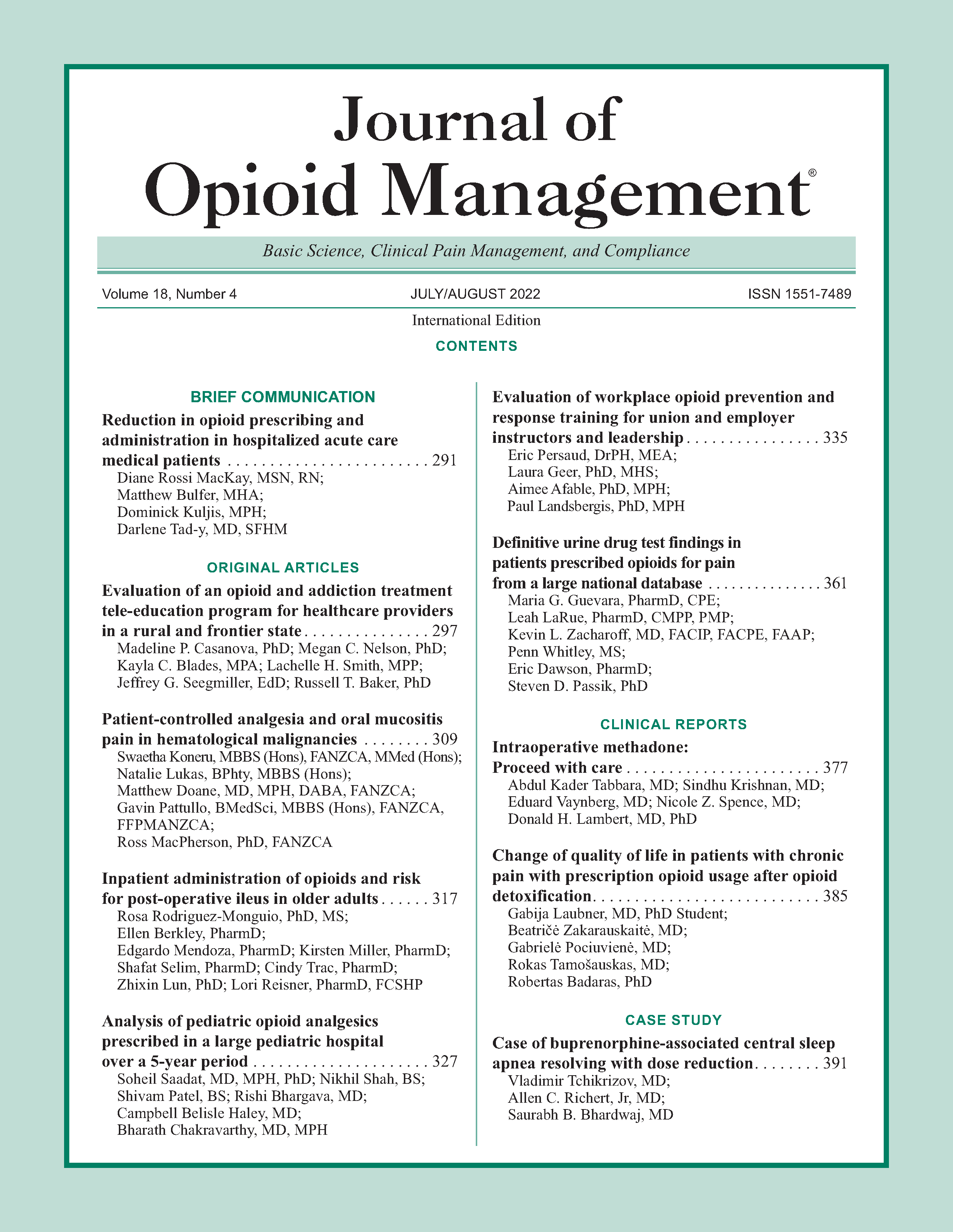Evaluation of workplace opioid prevention and response training for union and employer instructors and leadership
DOI:
https://doi.org/10.5055/jom.2022.0729Keywords:
workplace training, substance use, program evaluation, instructor training, leadershipAbstract
Objective: Opioids and the Workplace Prevention and Response (OWPR) Train-the-Trainer (TTT) and Leadership programs were piloted to improve trainees’ abilities to conduct opioid awareness training and to introduce policies and programs in their workplaces.
Methods: The TTT (N = 54) and Leadership (N = 19) pilot trainees were administered voluntary pre- and post-training surveys and observed for discussion on knowledge and confidence regarding teaching and on workplace policies and workplace injury prevention related to opioids.
Results: Percentage agreement with correct responses for all TTT and 10 out of 14 (71.4 percent) Leadership knowledge and confidence questions increased significantly from pre- to post-test.
Conclusion: We found some evidence that the OWPR TTT and Leadership training programs and materials were effective in improving trainee's abilities to conduct opioid awareness training and to introduce policies and programs to address opioids and the workplace.
References
Scholl L, Seth P, Kariisa M, et al.: Drug and opioid-involved overdose deaths—United States, 2013-2017. MMWR Morb Mortal Wkly Rep. 2018; 67(5152): 1419-1427. DOI: 10.15585/mmwr.mm675152e1.
Centers for Disease Control and Prevention: Annual surveillance report of drug-related risks and outcomes. 2018. Available at https://www.cdc.gov/drugoverdose/pdf/pubs/2018-cdc-drugsurveillance-report.pdf. Accessed March 28, 2022.
Shaw W, Roelofs C, Punnett L: Work environment factors and prevention of opioid-related deaths. Am J Public Health. 2020; 110(8): 1235-1241.
Hawkins D, Roelofs C, Laing J, et al.: Opioid-related overdose deaths by industry and occupation-Massachusetts, 2011-2015. Am J Ind Med. 2019; 62(10): 815-825. DOI: 10.1002/ajim.23029.
Lang J, Ochsmann E, Kraus T, et al.: Psychosocial work stressors as antecedents of musculoskeletal problems: A systematic review and meta-analysis of stability-adjusted longitudinal studies. Soc Sci Med. 2012; 75: 1163-1174.
Stansfeld S, Candy B: Psychosocial work environment and mental health—A meta-analytic review. Scand J Work Environ Health. 2006; 32(6): 443-462.
Halbert B, Davis R, Wee C: Disproportionate longer term opioid use among US adults with mood disorders. Pain. 2016; 157: 2452-2457.
Martins S, Fenton M, Keyes K, et al.: Mood and anxiety disorders and their association with non-medical prescription opioid use and prescription opioid-use disorder: Longitudinal evidence from the national epidemiologic study on alcohol and related conditions. Psychol Med. 2012; 42: 1261-1272.
Venkataramani AS, Bair EF, O'Brien RL, et al.: Association between automotive assembly plant closures and opioid overdose mortality in the United States: A difference-in-differences analysis. JAMA Intern Med. 2020; 180: 254. DOI: 10.1001/jamainternmed.2019.5686.
Dean A, Kimmel S: Free trade and opioid overdose death in the United States. SSM Popul Health. 2019; 8: 100409. DOI: 10.1016/j.ssmph.2019.100409.
The National Institute of Environmental Health Sciences Worker Training Program: Final report on the opioid training materials development initiative for the NIEHS worker training program. 2019. Available at https://tools.niehs.nih.gov/wetp/public/hasl_get_blob.cfm?ID=11661. Accessed March 28, 2022.
Slatin C, Dunn ML: From SARA to homeland security: The NIEHS worker education and training program confronts challenges of environmental cleanup. New Solut. 2006; 16(1): 65-86. DOI: 10.2190/6kl9-5x3j-f61m-kapa.
National Institute of Environmental Health Sciences Worker Training Program: Prevention of occupational exposure to fentanyl and other opioids. Available at https://tools.niehs.nih.gov/wetp/public/hasl_get_blob.cfm?ID=11206. Accessed March 28, 2022.
National Institute of Environmental Health Sciences Worker Training Program: Opioid-related hazards in the workplace developing a training framework to address exposure, use, and prevention report from fall 2018 workshop. 2018. Available at https://www.niehs.nih.gov/news/events/pastmtg/hazmat/assets/2018/wtp_fall_2018_workshop_report.pdf. Accessed March 28, 2022.
National Institute of Environmental Health Sciences Worker Training Program: Exploring workplace training interventions addressing workplace stress and addiction report from the Spring 2019 workshop. 2019. Available at https://www.niehs.nih.gov/news/events/pastmtg/hazmat/assets/2019/wtp_spring_19_report.pdf. Accessed March 28, 2022.
National Institute of Environmental Health Sciences: 2018-2023 strategic plan advancing environmental health sciences improving health. 2018. Available at https://www.niehs.nih.gov/about/strategicplan/index.cfm#:~:text=Thepercent20NIEHSpercent20strategicpercent20planpercent202018,EHSpercent20Throughpercent20Stewardshippercent20andpercent20Support. Accessed March 28, 2022.
Persaud E, Afable A, Geer L, et al.: Opioids and the workplace prevention and response awareness training mixed methods evaluation: 6-Month follow up. NEW Solut. 2021; 31(3): 271-285. DOI: 10.1177/10482911211010343.
The National Institute of Environmental Health Sciences Worker Training Program: Worker education and training program (WETP) logic model. Available at https://tools.niehs.nih.gov/wetp/1/12FallMeeting/wetp_logic_model.pdf. Accessed March 18, 2022.
American Medical Association: Issue brief: Reports of increases in opioid- and other drug-related overdose and other concerns during COVID pandemic. Available at https://www.ama-assn.org/system/files/issue-brief-increases-in-opioid-related-overdose.pdf. Accessed March 28, 2022.
National Institute of Environmental Health Sciences Worker Training Program: Minimum health and safety training criteria guidance for hazardous waste operations and emergency response (HAZWOPER) and HAZWOPER-Supporting training. 2018. Available at https://tools.niehs.nih.gov/wetp/public/hasl_get_blob.cfm?ID=11266. Accessed March 28, 2022.
Creswell JW: Designing a qualitative study. In Qualitative Inquiry and Research Design: Choosing among Five Approaches. Thousand Oaks, CA: Sage, 2007.
Smith JA, Jarman M, Osborne M: Doing interpretative phenomenological analysis. In Qualitative Health Psychology: Theories and Methods. 2nd ed. Thousand Oaks, CA: Sage, 1999.
Creswell JW: Advances in mixed methods research. Available at https://www.ualberta.ca/international-institute-for-qualitative-methodology/media-library/international-institute-of-qualitative-methods/webinars/mixed-methods/2016/jcreswellmmira-webinar.pdf. Accessed March 28, 2022.
Robson LS, Stephenson CM, Schulte PA, et al.: A systematic review of the effectiveness of occupational health and safety training. Scand J Work Environ Health. 2012; 38(3): 193-208. DOI: 10.5271/sjweh.3259.
Gayed A, Milligan-Saville JS, Nicholas J, et al.: Effectiveness of training workplace managers to understand and support the mental health needs of employees: A systematic review and meta-analysis. Occup Environ Med. 2018; 75(6): 462-470. DOI: 10.1136/oemed-2017-104789.
Calder R, Ainscough T, Kimergård A, et al.: Online training for substance misuse workers: A systematic review. Drugs Educ Prevent Policy. 2017; 24(6): 430-442. DOI: 10.1080/09687637.2017.1318113.
Cook DA, Levinson AJ, Garside S, et al.: Internet-based learning in the health professions: A meta-analysis. JAMA. 2008; 300(10): 1181-1196. DOI: 10.1001/jama.300.10.1181.
Bacharach SB, Bamberger PA, Sonnenstuhl WJ: MAPs: Labor-based peer assistance in the workplace. Ind Relat J Econ Soc. 1996; 35(2): 261-275. DOI: 10.1111/j.1468-232X.1996.tb00406.x
Persaud E, Weinstock D, Landsbergis P: Opioids and the workplace prevention and response train-the-trainer and leadership training mixed methods follow-up evaluation. Ann Work Expo Health. 2021. DOI: 10.1093/annweh/wxab112.
Published
How to Cite
Issue
Section
License
Copyright 2005-2024, Weston Medical Publishing, LLC
All Rights Reserved













